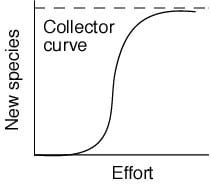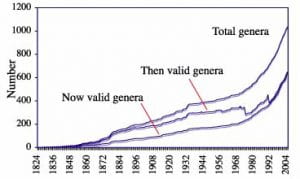A discovery curve (or collector curve, or species accumulation curve) is a plot of numbers of new taxa discovered against some measure of effort, perhaps the number of days or years of study, and the method was proposed as a way for ecologists to estimate how close they were to a reasonable representation of a species list from a particular locality or region (Preston 1948). Such curves can be plotted for ecological sampling within a restricted area, or at global scale for assessing the rate of discovery of taxa within a major clade in large-scale biodiversity studies.
 A complete discovery curve (= collector curve; left) might plot as a logistic, or S-shaped, curve, with a slow rate of discovery at the start, then a rapid rate of discovery, followed by an asymptote as sampling has recovered nearly all taxa. In estimating modern biodiversity, it is assumed that some groups, such as birds and mammals, are rather well collected, and so lie on the asymptote on a discovery curve (May 1990; Bebber et al. 2007). Other groups, such as insects, microbes, or meiofauna, where new taxa are discovered at a high rate, are presumably located somewhere on the rising part of the discovery curve.
A complete discovery curve (= collector curve; left) might plot as a logistic, or S-shaped, curve, with a slow rate of discovery at the start, then a rapid rate of discovery, followed by an asymptote as sampling has recovered nearly all taxa. In estimating modern biodiversity, it is assumed that some groups, such as birds and mammals, are rather well collected, and so lie on the asymptote on a discovery curve (May 1990; Bebber et al. 2007). Other groups, such as insects, microbes, or meiofauna, where new taxa are discovered at a high rate, are presumably located somewhere on the rising part of the discovery curve.
The discovery curve for dinosaurian genera shows a drawn-out somewhat exponential pattern, when all genera are considered (see Figure below). However, for valid genera the pattern is substantially damped. The numbers of “then valid” genera show large drops in 1973, 1990, and 2004 that coincide with the publication of major reviews (White 1973; Weishampel et al. 1990, 2004) that identified many synonyms and erroneous taxa. The ”now valid” curve is lowest, showing only the genera currently regarded as valid.
 The pattern of naming (‘discovery’) of dinosaur genera, from 1824 to 2004, inclusive. The three curves show the total numbers named, the “then totals” (running total of genera considered valid at the time), and the “now totals” (a retrospective running total of genera now considered valid.
The pattern of naming (‘discovery’) of dinosaur genera, from 1824 to 2004, inclusive. The three curves show the total numbers named, the “then totals” (running total of genera considered valid at the time), and the “now totals” (a retrospective running total of genera now considered valid.
Read more about the study
- Error in naming dinosaurs
- Naming organisms and biodiversity
- Naming and revision
- The dinosaur discovery curve
- (With all the money in the world) How to find new dinosaurs
- Who named most dinosaurs?
- Are we getting any better at it?
- Home – dinosaur names, error, and biodiversity
References
- Bebber, D. P., F. H. C. Marriott, K. J. Gaston, S. A. Harris, and R. W. Scotland. 2007. Predicting unknown species numbers using discovery curves. Proceedings of the Royal Society of London B 274, 1651-1658.
- May, R. M. 1990. How many species? Philosophical Transactions of the Royal Society of London B 330, 292-304.
- Preston, F. W. 1948. The commonness, and rarity, of species. Ecology 29, 254-283.
- Weishampel, D. B., P. Dodson, and H. Osmólska, eds. 1990. Dinosauria. University of California Press, Berkeley.
- Weishampel, D. B., P. Dodson, and H. Osmólska, eds. 2004. Dinosauria, 2nd ed. University of California Press, Berkeley.
- White, T. E. 1973. Catalogue of the genera of dinosaurs. Annals of the Carnegie Museum 44, 117-155.

